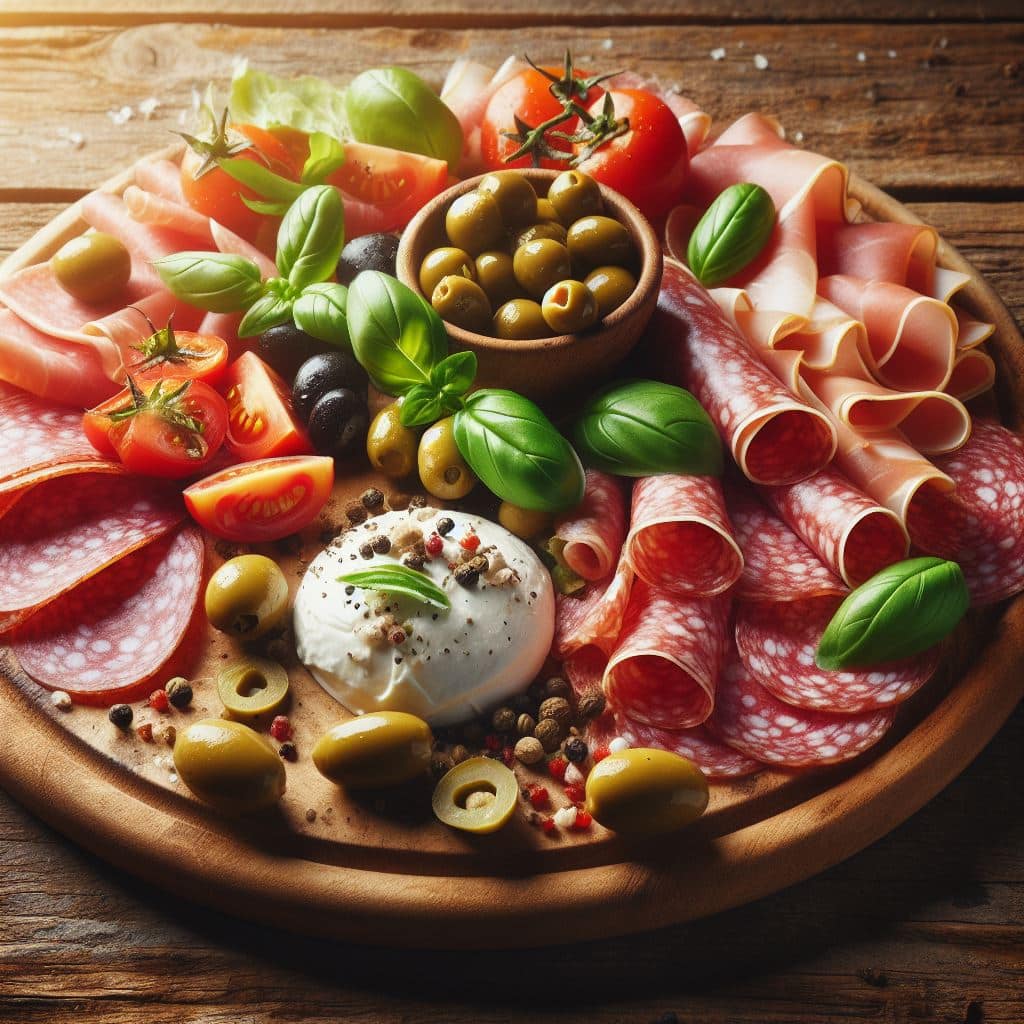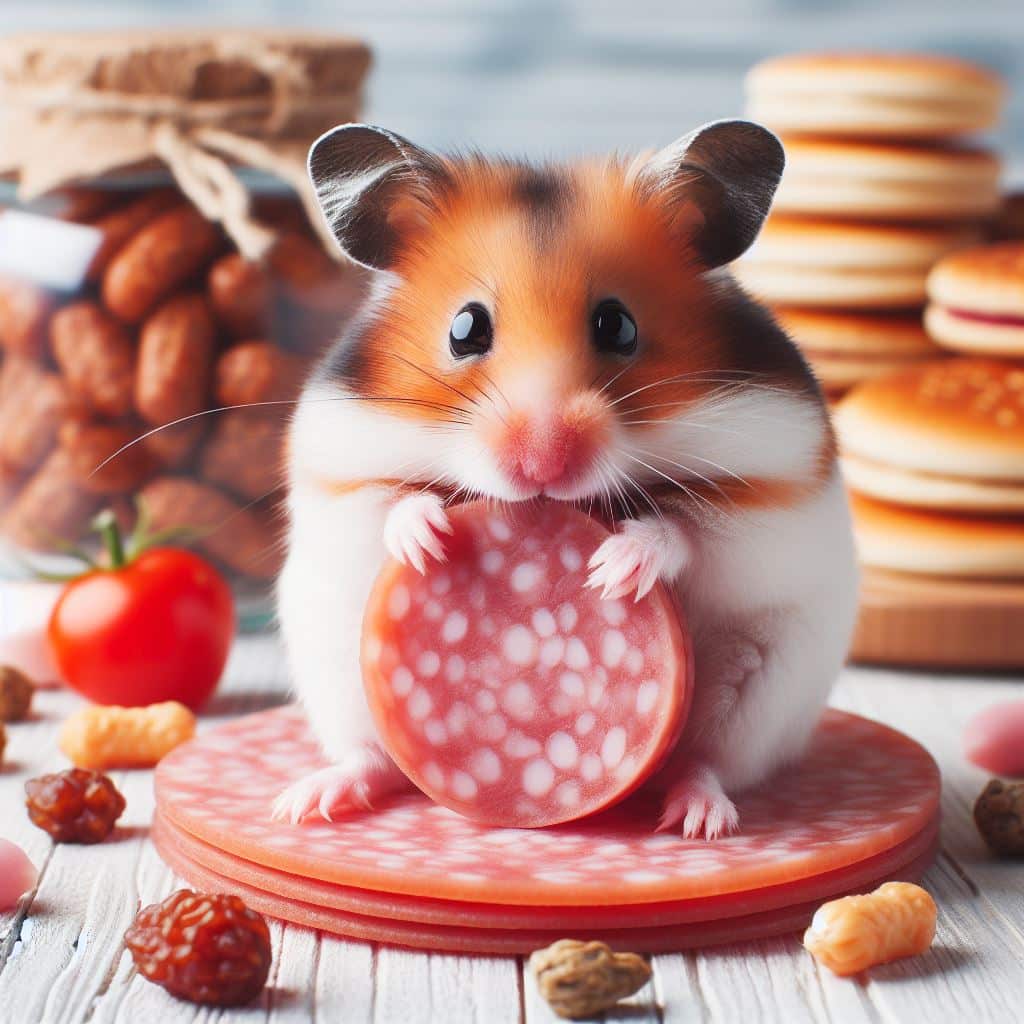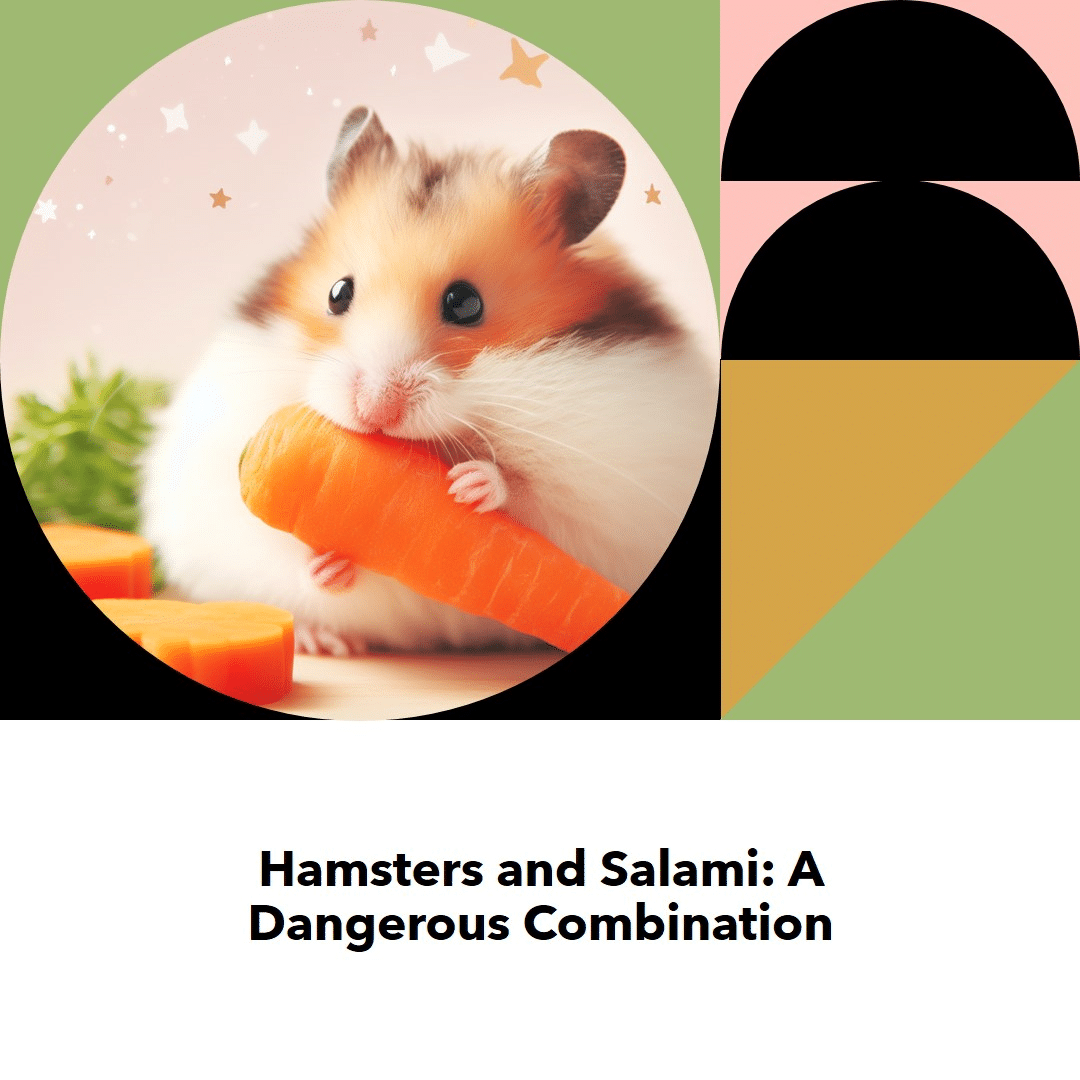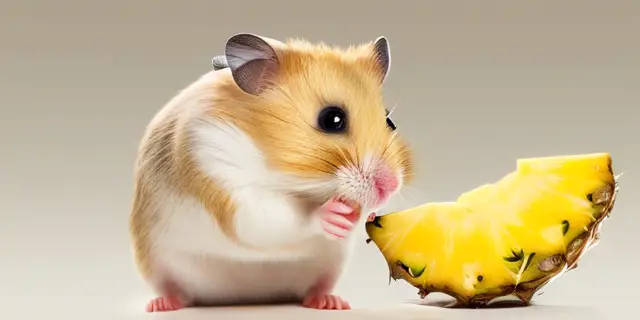As a caring hamster parent, you likely wonder what human foods are safe for your furry friend. One common question is whether hamsters can eat salami. This article will provide a comprehensive, evidence-based answer to help you make an informed decision about feeding salami to hamsters.
Table of Contents:
- What is Salami?
- Are Hamsters Allowed to Eat Salami?
- Nutritional Composition of Salami
- Health Risks of Feeding Salami to Hamsters
- What the Experts Say About Feeding Salami to Hamsters
- How Much Salami Can Hamsters Eat?
- Signs of Illness in Hamsters After Eating Salami
- Safer Human Food Alternatives to Salami for Hamsters
- Final Verdict: Should You Feed Your Hamster Salami?
What is Salami?

Before determining if salami is safe for hamsters, it helps to understand exactly what salami is. Salami falls into a category of cured meats called charcuterie. It originated in Italy as a way to preserve meat before refrigeration.
To make salami:
- Pork, beef, veal or poultry is finely ground
- The ground meat is seasoned with spices like garlic, salt, black pepper or paprika
- Starter cultures are added to ferment the meat
- The seasoned meat mixture is stuffed into casings
- Salamis are hung to cure for 1-3 months depending on size
This curing process helps preserve the meat and develop flavor. The end result is a firm, flavorful sausage that can be sliced and eaten without further cooking. There are many varieties of salami using different meats, seasonings, and curing methods.
Are Hamsters Allowed to Eat Salami?

So can hamsters join in enjoying this popular charcuterie meat? Let’s explore if salami is safe and healthy for hamsters.
The short answer is no – salami is not recommended for hamster consumption. While small nibbles very occasionally may not cause harm, regularly feeding salami to hamsters is generally advised against.
Hamsters have very different nutritional needs than humans. The high fat, salt and spice content of salami makes it inappropriate as a substantial part of a hamster’s diet.
Nutritional Composition of Salami
To understand why salami is not ideal hamster fare, let’s break down its nutritional makeup:
- High in fat – 40-50% of calories come from fat. This gives salami its rich flavor and smooth, tender texture. But too much fat long-term negatively impacts hamster health.
- High in sodium – Salami contains between 400-1200 mg of sodium per 100g. This salt content helps cure and preserve salami while enhancing its flavor. However, too much sodium is problematic for small hamsters.
- Nitrates/nitrites – These curing agents help prevent bacterial growth while giving salami its characteristic red color. But nitrates and nitrites can be toxic to some animals in high doses.
- Spices – Ingredients like garlic, paprika, pepper and other bold seasonings give salami its signature spicy, savory taste. Yet spices irritate sensitive hamster digestive systems.
- Hard texture – The dense, chewy texture of salami requires effort for hamsters to bite and chew. It also poses a choking risk.
So while salami suits the human palate, its composition makes it unsuitable as anything but an occasional treat for hamsters.
Health Risks of Feeding Salami to Hamsters
Given the unfavorable nutritional makeup of salami for hamsters, what are the health implications of offering salami to your small pet?
Unfortunately several possible adverse effects may occur, ranging from mild to dangerous or even life-threatening:
Weight Gain
The high fat and calorie content of salami is likely to cause rapid weight gain in hamsters. Excess weight stresses hamster organs, negatively impacting health. Obese hamsters also tend to be less active.
Gastrointestinal Distress
From nausea to vomiting, gas, bloating, diarrhea and constipation – salami may irritate the sensitive digestive tracts of hamsters. Spicy seasonings and dense texture make symptoms more likely.
Dehydration
High sodium levels coupled with fluid loss from diarrhea or vomiting can lead to dehydration. This electrolyte imbalance can cause serious health issues.
Pancreatitis
The rich fatty acid content of salami may inflame the pancreas. Pancreatitis causes abdominal pain, diarrhea, vomiting, fever and lethargy. Without treatment it can be fatal.
Heart Disease
Excess fat from salami can contribute to atherosclerosis – fatty plaque buildup in hamster arteries. This impedes blood flow, increasing the risk of heart attack or stroke.
Kidney Problems
The kidneys filter waste from the bloodstream – a task made harder with extra strain of metabolizing high-fat foods like salami. Kidney disease causes severe illness.
Diabetes
A fatty diet and obesity place hamsters at higher risk for diabetes. Insulin dysfunction leads to elevated blood sugar with life-threatening complications if left unmanaged.
Cancer
Nitrates used to cure meats like salami have been linked to increased cancer risk over time. Colon cancer is the most common type associated with processed meats.
Food Poisoning
Salami more easily harbors bacteria associated with food poisoning like Listeria, Salmonella, E. coli and Clostridium. Symptoms include vomiting, diarrhea and lethargy.
Choking Hazard
The dense, chewy texture of salami requires thorough chewing. Hamsters may swallow bigger chunks whole, leading pieces to become lodged in airways with fatal outcome.
As you can see, regularly feeding salami to hamsters has considerable health risks ranging from digestive upset to severe, chronic illness and choking. Occasional tiny nibbles likely won’t cause harm. But making salami a regular part of a hamster’s diet is ill-advised.
What the Experts Say About Feeding Salami to Hamsters
Research into hamster nutrition is still ongoing. But both veterinary and expert consensus agree salami should not comprise a substantial portion of hamster diets.
Organizations like:
- The American Veterinary Medical Association (AVMA)
- British Veterinary Association (BVA)
- Royal Society for the Prevention of Cruelty to Animals (RSPCA)
- People’s Dispensary for Sick Animals (PDSA)
All strongly advise against feeding salami as regular hamster fare. Let’s examine why experts specifically warn against salami for hamsters.
AVMA Guidelines on Feeding Hamsters
The AVMA Guide for the Care and Use of Laboratory Animals designates appropriate hamster diets. Their recommendations focus on providing a balanced, nutritional diet supporting health and wellness long-term.
Commercial hamster feed like pellets or seed mix deliver complete, species-appropriate nutrition not found in human foods. AVMA experts thus advise not substituting people food like salami as primary hamster fare.
BVA Guidance on Hamster Treats
The British Veterinary Association also offers input on suitable hamster snacks. Their hamster care guidelines permit limited treats provided these extras don’t exceed 10% of total food intake. Salami’s high fat and spice content makes it a poor treat choice likely to cause stomach upset if overfed.
RSPCA Guidelines on Processed Meat for Pets
What does a top animal welfare organization suggest regarding cured meats for hamsters? The RSPCA strongly discourages salami for small animals given health risks from excess fat, salt and preservatives over time. They recommend not regularly feeding processed meat.
PDSA Guidance on Avoiding Obesity in Hamsters
Another respected animal charity – PDSA – also advises against offering salami. Since obesity undermines hamster wellness, the fat and calorie density of salami works against maintaining healthy weights. Limiting exposure to fatty human snacks keeps hamsters trim.
In summary, experts in veterinary medicine and animal welfare agree: While an occasional small bite of salami may not be immediately harmful, it is absolutely not recommended as a routine part of a hamster’s diet.
How Much Salami Can Hamsters Eat?
Ideally hamsters should not eat any salami whatsoever. Yet you may be wondering just how much salami would be safe for a hamster to eat.
As we’ve discussed, salami provides little positive nutritional value for hamsters. It mainly contributes unnecessary fat, salt and seasonings that stress hamster health over time.
But many caring hamster owners still wish to share a bit of their favorite foods with their petite pets. If you absolutely must offer your hamster a salami sample, follow these dosage guidelines:
- No more than 1 TINY piece of salami 1-2 times per year
- Shred or finely dice the salami into peanut-sized pieces
- Limit portion to a few tiny bits – equivalent to roughly 1 tbsp maximum
- Mix salami bits into commercial hamster feed
Following these conservative dosing guidelines restricts salami to a very occasional treat rather than a true diet component. This small exposure prevents cumulative negative effects from too much fat, sodium etc over time.
Yet even these tiny sampling sizes may still cause temporary GI upset or diarrhea. How do you know if allowing even a rare salami treat was a bad idea?
Signs of Illness After Eating Salami
Pay close attention to your hamster’s condition after trying new foods like salami. Suboptimal nutrition choices or food sensitivities manifest through symptoms. But hamsters disguise illness well thanks to prey animal instincts.
Note these common indicators of discomfort or distress:
Lethargy – decreased activity or seeming tired, hunched posture
Poor Coat Condition – dull, brittle fur lacking sheen and softness
Diarrhea – loose or watery stools, stuck to fur near bottom/tail
Vomiting – partially digested food expelled from mouth
Gas – stomach distension or flatulence
Abnormal Eating Habits – loss of appetite, inability to eat
If you observe any concerning symptoms within 24 hours of feeding salami:
- Remove salami immediately
- Book vet appointment for assessment
- Feed bland diet like Timothy hay until recovered
Though most cases resolve after stopping trigger foods, prompt vet care is crucial if acute illness occurs.
Safer Human Food Alternatives
Preventing health issues from treats like salami is easier by selecting safer snack alternatives agreeing with hamsters. Here are healthier human foods to offer instead:
- Carrot or broccoli florets – Wash thoroughly and offer a few small pieces at a time
- Plain popcorn – Feed air-popped kernels without salt, butter etc
- Plain pasta or rice – Cook al dente without oil, serve 1-2 tbsp
- Oats – Dry oatmeal or a spoonful of cooked porridge
- Unsweetened cereal – Just a few pieces of healthier kinds without frosting
- Apple slices – Always wash fruit and remove seeds first
- Blueberries – Just 1-2 fresh berries at a time
- Plain yogurt – Look for unsweetened kinds with live active cultures
- Hard boiled egg – Offer tiny portion of cooked egg white or yolk
- Chicken – Natural baked or grilled plain chicken offers protein
Unlike salami, these healthier people foods align better with hamster nutritional needs. Small servings also prevent obesity or illness. Check with your veterinarian if any treats cause concerning symptoms nonetheless.
Final Verdict: Should You Feed Your Hamster Salami?
Can hamsters eat salami then? After reviewing all evidence, science indicates salami is not recommended for hamsters for several reasons:
- Minimal nutritional value for hamsters
- Too high in fat, sodium and nitrates harmful long-term
- Spice content disturbs sensitive digestion
- Dense texture poses choking hazard
- Can trigger obesity along with chronic, potentially fatal illness like pancreatitis
Therefore the verdict is clear – hamsters should not eat salami, or at minimum only TINY portions EXTREMELY rarely. Any symptoms of illness immediately after require prompt veterinary care. For their health and safety, provide hamsters proper commercial diets instead of high-risk human treats like salami.
With this comprehensive, evidence-based guide, hamster owners can now make fully informed decisions about whether or not to feed salami to their small pets. Avoid guesswork by relying on scientific recommendations as well as input from qualified experts.
Put your hamster’s wellbeing first by steering clear of salami. Instead offer safer human food snacks occasionally for a special treat that won’t compromise their health. Follow these clear guidelines for keeping your hamster happy and healthy while still sharing tidbits of your favorite foods!



